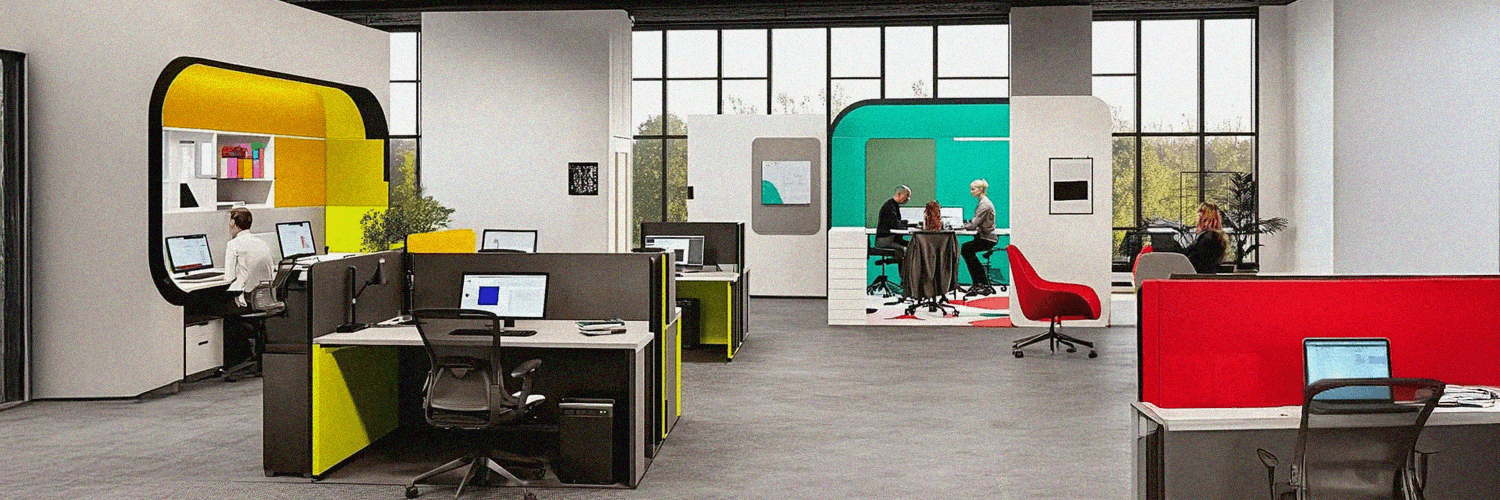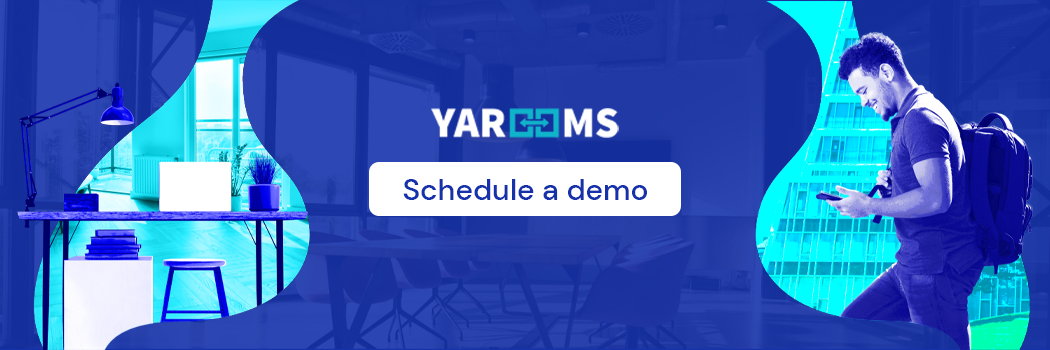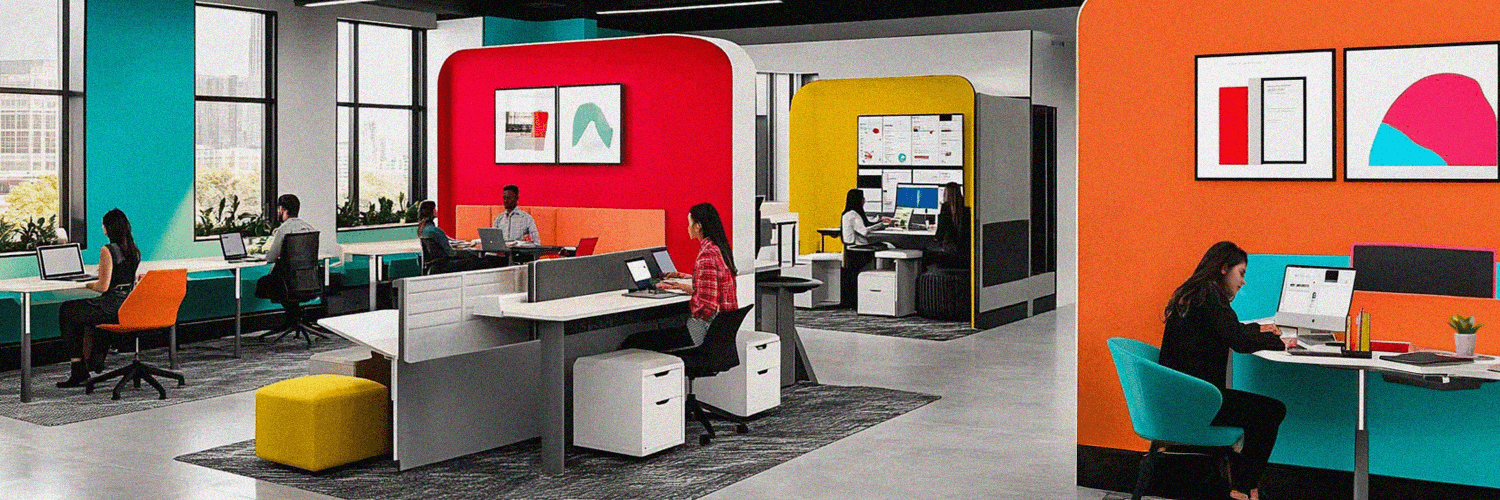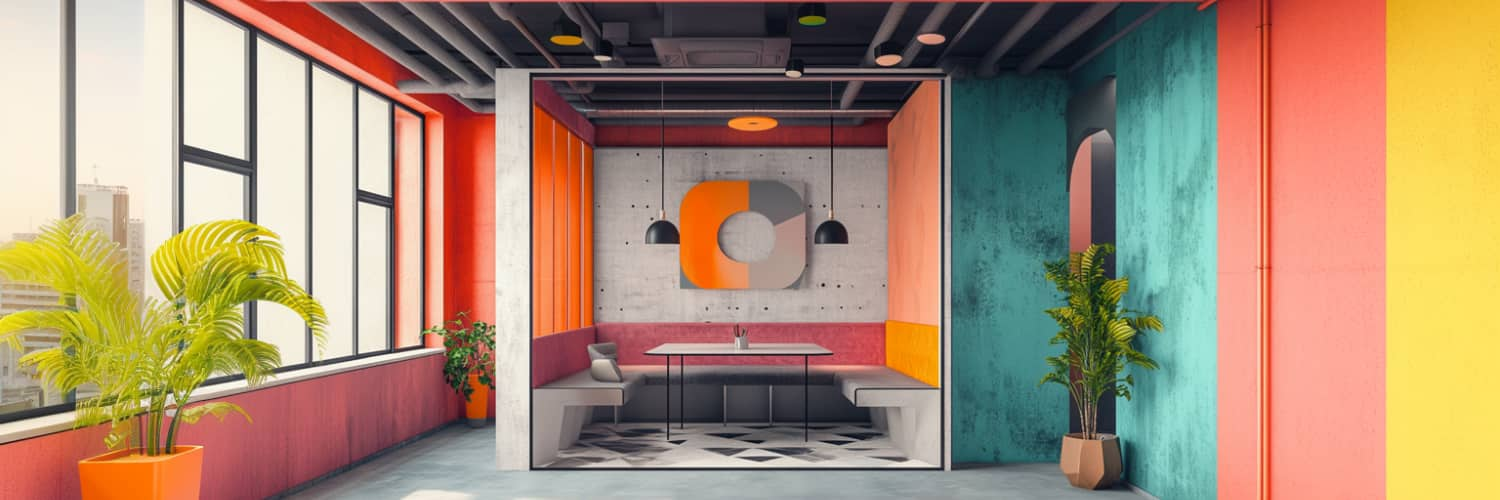The future of the office sparks curiosity because it lies at the crossroads of many uncertainties - advancing technology, shifting cultural values, and more profound questions about how we connect to work and each other. It invites us to wonder about its appearance and how it will function, feel, and reshape our lives.
So, how will the modern workplace and its core element - the office - change in the near future? Data gives us a glimpse into exciting trends like flexible work models, hybrid setups, and innovations designed to boost productivity and well-being. The office is shifting from a fixed location to a dynamic space that adapts to our changing needs. Let’s take a closer look at what lies ahead.
TL;DR:
-
Offices will become dynamic, flexible spaces that adapt to the needs of employees throughout the day.
-
Hybrid work will persist, with offices still valued for collaboration and community connection.
-
AI will revolutionize office design by providing data insights to create personalized, efficient work environments.
-
Offices will feature multi-functional spaces that allow for both focused work and team collaboration.
-
Automation will streamline office operations, improving efficiency and employee satisfaction.
-
Thoughtful design will become more important than perks, focusing on functionality over amenities.
-
Sustainability will be a key priority, with companies expected to invest in green initiatives.
-
Air quality, ergonomic furniture, and natural lighting will be prioritized to support health and well-being.
-
Digital collaboration tools will bridge the gap between remote and in-person work, enhancing productivity.
-
Inclusivity and accessibility will be central to office designs, ensuring spaces accommodate diverse needs.
-
Privacy and security concerns will drive the integration of advanced digital and physical security measures.
-
Smaller, more efficient office spaces will replace large, underutilized office buildings.
The Future of the Office Has Arrived
You don't have to look far ahead - what once seemed like distant predictions about hybrid models, advanced technology, and flexible work environments is becoming a reality today. Business leaders are already reshaping workplace culture, blending on-site and remote work, and adopting innovations to enhance productivity and employee experiences. The changes we anticipated for the future are unfolding rapidly, and their impact will be visible sooner than we think.
This is why understanding the office of the future isn't just a curious read - it's a critical benchmark. It helps you evaluate whether you're keeping pace with the transformation happening right now.

The Value of Offices Persists Despite the Flexible Work Model
Despite the rise of hybrid work, office attendance is only down by 30% from pre-pandemic levels, indicating that many employees still find it valuable for specific tasks and interactions. People are increasingly coming to the office for collaboration, access to a variety of workspaces, and the opportunity to feel more connected to their work community. These aspects underscore the physical environment's critical component in fostering organizational culture and supporting employees' diverse needs.
To make your office future-proof, it's essential to focus on elements that enable these benefits - creating spaces that encourage knowledge sharing, supporting a diverse workforce needs, and enhancing company culture. By doing so, businesses can balance a more flexible work model with the undeniable advantages of a well-designed office, ultimately helping employees achieve better work-life balance while unlocking their human potential.
The Future of the Office: Data Paints a Picture of What's Ahead
Data reveals fascinating trends reshaping how offices look and how they are used. Many companies are moving toward more flexible layouts, prioritizing collaboration and employee well-being. At the same time, the integration of innovative technologies is transforming traditional workspaces into dynamic environments that adapt to the needs of their users.
AI and Office Redesigns: A 200% Boost in Employee Attendance
The future of office design is set to be revolutionized by AI tools, which offer unparalleled capabilities for delivering actionable data insights. These insights empower decision-makers to create workspaces that align closely with employee needs and preferences.
The shift toward data-informed design is pivotal as Human Resources and Facilities departments navigate the challenges of hybrid work models and the enforcement of return-to-office (RTO) mandates. A persistent question - how to make employees fall in love with the office again - may finally have a solution in AI. Honghao Deng, CEO of Butlr Technologies, demonstrated this potential when his company used AI-enabled technology to gather and analyze office usage data. By redesigning their space based on these insights, Butlr Technologies achieved a staggering 200% increase in voluntary office attendance, underscoring the transformative impact of latest technologies.
As AI continues to advance, its ability to personalize office environments, predict employee preferences, and optimize space usage will shape the evolution of the workplace.
Multi-Functional Spaces: 40% of Employees Want Offices That Adapt to Their Needs
In the office space of the future, flexibility is key. Employees increasingly expect workplaces that adapt to their changing needs throughout the day, with 40% specifically demanding spaces that can transform as required. This could mean starting the day in quiet pods designed for focused work, transitioning to collaborative zones for brainstorming sessions, and wrapping up with casual meeting spaces that foster informal discussions.
This shift reflects a growing recognition that one-size-fits-all office designs no longer work. Companies are responding by implementing modular furniture and reconfigurable layouts that allow spaces to serve multiple purposes throughout the day. For example, a room equipped with movable walls can transition from a quiet work zone in the morning to a collaborative hub in the afternoon. Advanced AI and sensor technologies also play a role in analyzing real-time data on space utilization to guide decisions about optimizing layouts.
To stay ahead, businesses should prioritize investments in adaptable infrastructure and design strategies that directly address employee needs, ensuring every square foot of office space adds value to their experience and productivity.

Automation: 70% of Organizations to Implement It Across Various Processes
In 2025, 70% of organizations are expected to implement structured automation across various processes, revolutionizing workplace operations. This trend will include innovations like automated booking systems for meeting rooms and desks, ensuring efficient use of space and eliminating the frustration of manual scheduling conflicts. Smart building management systems will also become mainstream, automating climate control, lighting, and energy management based on real-time occupancy and environmental data.
These technologies will significantly enhance operational efficiency while creating more seamless and enjoyable experiences for employees. Beyond convenience, automation allows workplace managers to focus on strategic initiatives rather than being bogged down by routine tasks. As organizations embrace these tools, they will reduce costs and improve sustainability and employee satisfaction, setting a new standard for modern office environments.
Design Over Amenities: Only 16% of UK Workers Value Extras Like Gyms or Free Food
The data shows a clear shift in workplace priorities, marking a new era in how organizations approach office design. In the past, companies competed by offering lavish perks like gyms and free food. However, today's workforce places greater value on thoughtful, functional spaces that enhance productivity. According to recent research, only 16% of UK workers consider these extras important, emphasizing that the focus has shifted from superficial amenities to creating work environments that truly meet employee needs.
For most employees, especially working parents and those accustomed to a home environment, a well-designed office can bridge the gap between the flexibility of working remotely and the advantages of face-to-face interaction. Interactive whiteboards, modular layouts, and spaces that encourage emotional intelligence and collaboration are becoming integral features of modern offices.
Sustainability: 69% of Employees Want Companies to Invest in Green Efforts
Environmental consciousness is becoming a cornerstone of office design, reflecting the growing demand for sustainability in the workplace. With 69% of employees calling for green workplace initiatives, sustainable practices have shifted from “nice-to-have” to an essential element of modern office spaces.
Companies are responding by integrating energy-efficient systems, such as smart lighting and HVAC systems, that reduce energy consumption while maintaining a comfortable environment. Additionally, sustainable materials like recycled or reclaimed wood, non-toxic paints, and low-impact furnishings are becoming standard choices in redesigns. Waste reduction programs, including composting and recycling systems, further demonstrate a commitment to environmental stewardship.
These measures are especially significant for Gen Z, a strongly value-driven generation with an acute sense of authenticity. They see workplace sustainability not as a trend but as a responsibility and expect companies to reflect these values in tangible ways. As Gen Z continues to enter the workforce, their influence will make green office design an even more critical factor in attracting and retaining top talent.

Health & Well-Being: 58% of CRE Professionals Prioritize Air Quality in Office Design
Health and well-being have become central to the future of office design, reflecting a broader understanding of how physical environments impact employee performance and satisfaction. Today, 58% of commercial real estate professionals say their office design priority is ensuring air quality. This focus goes beyond standard filtration systems, incorporating advanced technologies that monitor and optimize indoor air conditions in real time, providing a healthier workspace.
This emphasis extends to other critical elements, such as maximizing natural lighting to boost mood and productivity and integrating biophilic design features like indoor plants and green walls to foster a connection to nature. Ergonomic furniture also plays a pivotal role, as companies invest in adaptable desks, chairs, and accessories that promote comfort and reduce physical strain. These designs are not just aesthetic choices but deliberate strategies to enhance well-being and reduce workplace fatigue.
Digital Collaboration Tools: 20% of Remote Workers Face Collaboration Challenges
While technology has made remote working a cornerstone of the modern workplace, significant challenges persist, particularly in collaboration. With 20% of remote employees struggling to collaborate effectively, the future of work hinges on bridging the gap between remote and in-person experiences. As companies prepare for the next phase of workplace evolution, adopting advanced digital tools and hybrid-friendly office spaces will be crucial.
The future offices will integrate cutting-edge technologies, such as AI-powered collaboration platforms, immersive virtual meeting environments, and interactive whiteboards that allow seamless participation regardless of location. These tools will move beyond replicating in-person experiences to creating new ways of working together. Hybrid-friendly office designs will also play a pivotal role, offering dynamic spaces with innovative technology that can adapt to different collaboration styles, from remote brainstorming to mixed-team workshops.
By investing in these forward-thinking solutions, organizations can overcome the limitations of remote work and build a cohesive, agile workforce. This integration of technology and design will enhance productivity and define the next era of work, ensuring teams thrive in a world where flexibility and connection are equally valued.
Inclusivity & Accessibility: Only 20.6% Feel Their Workplace Is Fully Inclusive
The future of offices must address a critical challenge: only 20.6% of employees feel their workplace is truly inclusive. This alarming statistic underscores the urgent need for office designs beyond aesthetics to accommodate diverse needs. Inclusivity in the workplace should encompass physical accessibility, ensuring spaces are navigable for people with disabilities through features like ramps, elevators, and adjustable furniture. However, it must also consider broader elements, such as quiet zones for neurodiverse employees, prayer or meditation rooms for cultural inclusivity, and gender-neutral restrooms.
In the offices of the future, inclusivity will extend to fostering a sense of belonging through thoughtful layouts and the use of technology. AI-driven tools could help analyze usage patterns to ensure equitable access to resources, while hybrid setups must account for the specific challenges faced by remote workers from underrepresented groups. Cultural sensitivity in design, from artwork and color schemes to communal areas that encourage collaboration across diverse teams, will further reinforce inclusivity as a core value.
Listen to the Workplace Whiz podcast: accessibility challenges in hybrid workplaces
Safety Measures: 84% Are Concerned About Privacy & Security
Security concerns increasingly dominate workplace discussions, with 84% of employees expressing concerns about privacy and security. In the office of the future, addressing these concerns will be paramount, requiring a careful balance between fostering openness and collaboration while implementing robust security measures to safeguard both digital and physical assets.
On the digital front, workplace IT infrastructure will need to incorporate advanced cybersecurity protocols to protect sensitive data. This includes end-to-end encryption, multi-factor authentication, and AI-driven threat detection systems that identify and neutralize real-time risks. Hybrid workplaces, which often involve employees working from multiple locations and devices, will necessitate secure virtual private networks (VPNs) and zero-trust frameworks to ensure that only authorized users can access critical systems and information.
In the physical realm, security will revolve around intelligent access control systems and visitor management policies. Offices of the future are likely to integrate technologies such as biometric authentication, smart locks, and surveillance systems powered by AI to monitor and control who enters the workspace. Visitor management systems will track and authenticate guests in real-time, ensuring that every individual on-site is accounted for. Moreover, physical layouts may include secure zones for handling sensitive operations, keeping these areas separate from more collaborative, open spaces.
Smaller Offices: US Real Estate Values Could Drop Over 30% by 2030
The future of the office is leaning toward more compact and efficient designs, signaling a major departure from the sprawling office complexes of the past. With predictions of a 30% drop in US real estate values by 2030, businesses are reevaluating how they use physical space. Instead of maintaining expansive offices with underutilized areas, companies focus on smaller, purpose-driven workspaces that maximize utility and reduce waste.
These compact offices are designed to prioritize functionality and adaptability. Modular layouts, multifunctional furniture, and shared spaces like hot-desking zones are staples of this new approach, allowing companies to create dynamic environments that cater to different needs without requiring excessive square footage. Smart technology advances further enhance these spaces' efficiency by optimizing energy use, monitoring occupancy, and facilitating seamless collaboration between on-site and remote employees.
This shift also aligns with broader trends in sustainability and cost efficiency. By reducing their real estate footprint, organizations can cut operating expenses, lower their environmental impact, and reinvest resources into other areas, such as employee well-being and technology upgrades. As more businesses embrace this model, the office of the future will be characterized by compact yet highly productive spaces designed to support modern workstyles and meet the needs of a flexible workforce.

Manage the Future Office With YAROOMS
As workplaces evolve, managing office spaces effectively has become more complex than ever. YAROOMS steps in as a comprehensive solution, helping organizations navigate the challenges of modern workplace management with intuitive tools and data-driven insights.
The platform offers a robust suite of features designed to streamline office operations. From desk booking to meeting room management, YAROOMS provides the flexibility needed to support dynamic work environments. Employees can easily find and reserve the spaces they need, while managers gain valuable insights into space utilization patterns.
One of the standout aspects of YAROOMS is its ability to support data-driven decision-making. The platform's analytics tools help organizations understand how their spaces are being used, enabling them to optimize their office layout and resources based on actual usage patterns. This information is invaluable for companies looking to right-size their office footprint and create more efficient workspaces.
Beyond basic space management, YAROOMS helps foster better collaboration and employee engagement. The platform makes it simple for team members to coordinate their office visits, ensuring they can maximize face-to-face time with colleagues. This feature is particularly valuable for organizations embracing hybrid work arrangements, where coordinating in-person meetings requires careful planning.
Security and compliance are also key priorities. YAROOMS incorporates robust privacy features and customizable access controls, ensuring your workplace management system aligns with your organization's security requirements. This comprehensive approach to workplace management helps create a more organized, efficient, and productive office environment.
Answering the Most Popular Questions About Offices of the Future
What Is the Future of Offices?
The future of office space is undergoing a remarkable transformation. Rather than traditional cubicle-filled environments, offices are evolving into dynamic hubs prioritizing flexibility and human connection. These spaces will blend the best aspects of remote work with in-person collaboration, creating environments that support various work styles and preferences. Technology integration, sustainability features, and wellness-focused design elements will become standard rather than luxury additions.
What Will the Workplace Look Like in 5 Years?
Looking at the future of the office, we can expect significant changes by 2030. Workplaces will likely feature:
-
AI-powered smart building systems that automatically adjust to occupant needs
-
Modular spaces that can transform based on daily requirements
-
Advanced collaboration technologies that seamlessly connect remote and in-person workers
-
Sustainable design elements, including living walls and natural lighting
-
Wellness zones dedicated to mental health and physical well-being
How Will Office Workers Look In the Future?
The office of the future will see a new breed of workers who are more adaptable and tech-savvy than ever before. These professionals will seamlessly switch between virtual and physical workspaces, utilizing advanced digital tools for collaboration and productivity. They'll likely have more control over their work schedules and locations, leading to better work-life integration and increased job satisfaction.
Are Co-working Spaces the Future of Office Space?
Coworking spaces represent a significant component in the future of offices, but they're not the only solution. These flexible environments offer several advantages that align with modern work trends:
-
On-demand access to professional workspaces
-
Opportunities for networking and community building
-
Reduced overhead costs for businesses
-
Access to premium amenities without long-term commitments
However, the future of office space will likely involve a mix of traditional offices, co-working spaces, and remote work options, creating an ecosystem that supports diverse working preferences and business needs. This hybrid approach allows organizations to maintain their corporate culture while providing the flexibility that modern workers demand.











